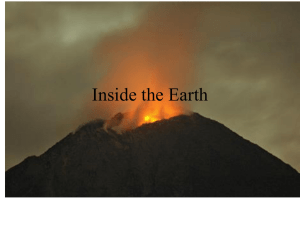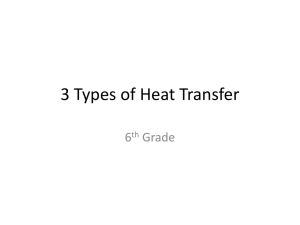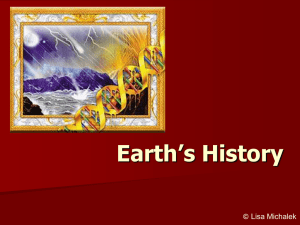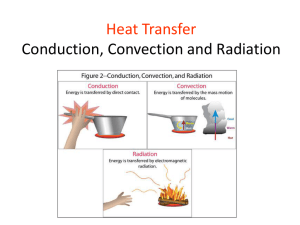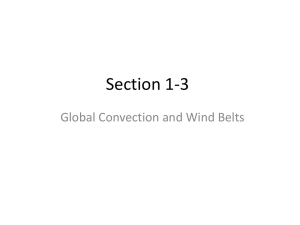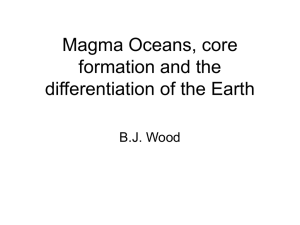Lesson 3 Convection and Mantle
advertisement
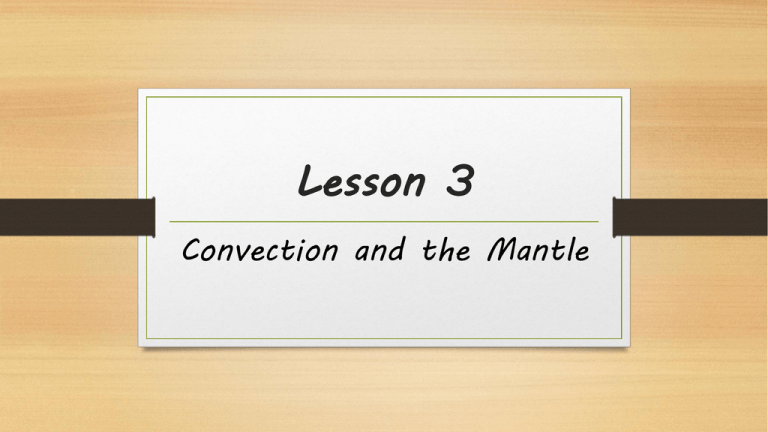
Lesson 3 Convection and the Mantle Vocabulary • radiation-the transfer of • density-measure of how much • convection-heat transferred • convection current-the flow that • conduction-heat transferred • gravity-the force that pulls energy that is carried in rays like light by the movement of fluids between materials mass there is in a given volume of a substance transfers heat within a fluid objects toward each other and toward Earth’s center Introduction Did you know that the solid rock in Earth’s mantle can flow like a fluid? To learn this concept look at a lava lamp. Heat from the bulb causes solid globs of wax at the bottom to expand. As they expand, the globs become less dense and then rise through the more dense fluid that surrounds them. In Earth’s mantle, great heat and pressure create regions of rock that are less dense than the rock around them. Over millions of years, the less dense rock slowly rises-like the solid globs in the lava lamp. How Is Heat Transferred? • Heat is constantly transferred inside Earth and all around Earth’s surface. For example, the warm sun heats the cooler ground • Heat always moves from a warmer object to a cooler object • When an object is heated, the particles that make up the object move faster, these faster-moving particles have more energy • The movement of energy from a warmer object to a cooler object is called heat transfer • There three types of heat transfer: radiation, conduction, and convection • Radiation-the sun constantly transfers light and heat through the air, warming your skin. The transfer of energy that is carried in rays like light is called radiation • Conduction-your feet can feel the warmth of hot sand, you will feel that your feet are burning. The sand transfers its heat to your skin. Heat transferred between materials that are touching is called conduction. • Convection-the currents of warm air are created when warm air rises from the ground, they will cool down as it rises to the air above that is cooler. Heat transfer by the movement of a fluid is called convection. Methods of Heat Transfer Assess • Work with a classmate to think of other examples of heat transfer: conduction, convection, and radiation. HINT: think about different ways to cook food. Write your answer on a piece of paper using this format: • Radiation • Convection • Conduction How Does Convection Occur in Earth’s Mantle? • When you heat soup on a stove, convection occurs in the soup • The soup at the bottom of the pot gets hot and expands • As the soup expands, its density decreases • The warm, less dense soup above the heat source moves upward and floats over the cooler, denser soup • Near the surface, the warm soup cools, becoming denser • Gravity then pulls the colder soup back down to the bottom of the pot • Then, it is reheated and rises again • A constant flow begins: cooler, denser soup sinks to the bottom and at the same time, warmer, less dense soup rises • The flow that transfers heat within a fluid is called convection current • Heating and cooling of a fluid, changes in the fluid’s density, and the force of gravity combine to set convection currents in motion • Without heat, convection currents eventually stop Video • https://www.youtube.com/watch?v=Kpoko_l34ZE Remember • Remember that Earth’s mantle and core are extremely hot • Heat is transferred within Earth by convection currents • Remember that density is a measure of how much mass there is in a given volume of a substance • For example, most rock is more dense than water because a given volume of rock has more mass than the same volume of water Apply It! • Hot springs are common in Yellowstone Park. Here, melted snow and rainwater seep to a depth of 3,000 meters, where a shallow magma chamber heats the rock of Earth’s crust. The rock heats the water over 200C and keeps it under very high pressure. Compare and Contrast • The heated water is more or less dense than the melted snow and rainwater? • What might cause convection currents in a hot spring? Convection Currents in Earth • Inside Earth, heat from the core and the mantle act like the stove that heats the pot of soup • Large amounts of heat are transferred by convection currents within the core and the mantle • Heat from the core and the mantle itself causes convection currents in the mantle Convection Currents To understand better, let’s take a look at this figure Temperature: colder Density: more dense The rock: sinks Temperature: hotter Density: less dense The rock: rises How is it possible for mantle rock to flow? • Over millions of years, the great heat and pressure in the mantle have caused solid mantle rock to warm and flow very slowly • Many geologists think plumes of mantle rock rise slowly from he bottom of the mantle toward the top • The hot rock eventually cools and sinks back through the mantle • Over and over, the cycle of rising and sinking takes place • Convection currents like these have been moving inside Earth for more than four billion years! • There are also convection currents in the outer core. These convection currents cause Earth’s magnetic field Assess • A convection current transfers _______ (heat/air/density) within a fluid. • In which part of Earth’s core do convection currents occur? • What would happen to the convection currents in the mantle if Earth’s interior eventually cooled down? Why? • Why is it colder near the floor than near the ceiling? • How is heat transferred? • What are the three types of heat transfer? • • • • • • • • • What is gravity? What effect does gravity have in convection currents? What could cause rock to rise through Earth’s mantle? Why might rock sink into Earth’s mantle? How can solid rock flow? Which Earth’s layers have convection currents? Where is the hottest rock in the mantle? Where is the coolest rock in the mantle? How does the density of most substances change when the substance is heated?

